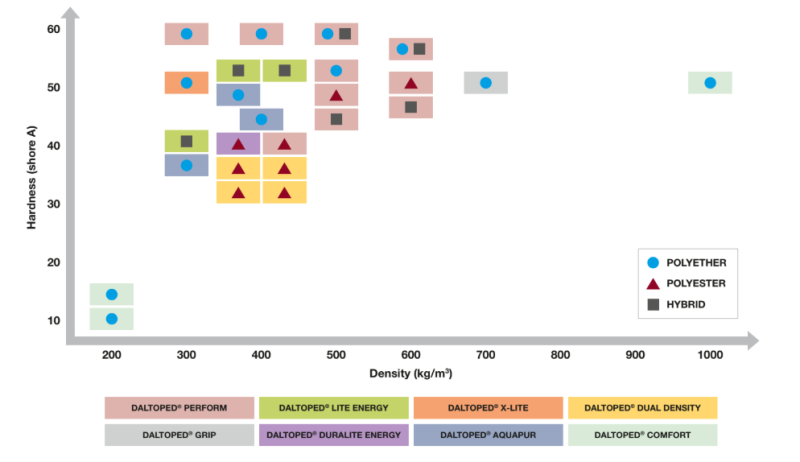Enhanced TDS
Identification & Functionality
- Blend
- No
- Chemical Family
- Polymer Name
- Single Ingredient
- Yes
- Technologies
- Product Families
Features & Benefits
- Labeling Claims
- Materials Features
- Product Advantages
Hard wearing outsoles:
- Density range 1.2 down to 0.7 kg/m3 depending on design
- Rubber-like grip and feel
- Non-floor marking
- Excellent abrasion resistance
- Good surface definition
- Improved sole flexibility (Bata belt / Bennewardt).
Lightweight comfortable midsole:
- Better cushioning
- Multiple colors possible (fashion oriented).
Productivity:
Compatible with standard polyurethane injection and casting machines; cumbersome stick on processes can be avoided.
Applications & Uses
- Plastics & Elastomers End Uses
- Plastics & Elastomers Processing Methods
Technical Details & Test Data
- Technical Data

- Typical Technical Properties
Polyether DALTOPED® DUAL DENSITY*
Outsole Outsole Midsole Midsole Density (kg/m3) 1000 kg/m3 800 kg/m3 450 kg/m3 300 kg/m3 Hardness (Shore A) 60 50 45 40 Trouser tear (N/mm) 9.0 8.5 5.5 4.0 Tensile strength (MPa) 5.5 5.0 3.0 2.0 Elongation (%) 450 400 350 300 Flex life Bennewardt 30 / 60 kcycl 0-0-0 0-0-0 N/a N/a Abrasion (mg loss) 40-80 60-100 N/a N/a *DALTOPED® DUAL DENSITY system based on polyether technology
Polyester DALTOPED® DUAL DENSITY*
Outsole Outsole Midsole Midsole Density (kg/m3) 1200 kg/m3 800 kg/m3 450 kg/m3 400 kg/m3 Hardness (Shore A) 65 55 45 40 Trouser tear (N/mm) 12.0 10.0 6.0 5.0 Tensile strength (MPa) 9.5 8.0 4.0 3.0 Elongation (%) 600 550 400 350 Flex life Bennewardt 30 / 60 kcycl 0-0-0 0-0-0 N/a N/a Abrasion (mg loss) 40-80 60-100 N/a N/a * DALTOPED® DUAL DENSITY system based on polyester technology
